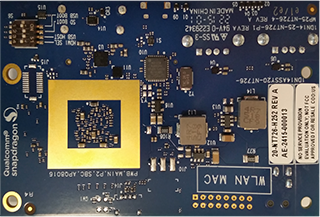Snapdragon and Qualcomm branded products are products of
Qualcomm Technologies, Inc. and/or its subsidiaries.
Your phone is your next robot.
- The energy in its battery can lift an adult about 20 stories.
- It has more computing power than the supercomputers of the early 1990s.
- It can replace at least 6 other electronic devices (GPS, music player, camera, computing device, photo frame, game console).
- It can decode the signal from a cell tower even when the signal has degraded to one hundred-thousand-billionth of its original strength.
That’s how Matt Grob, EVP and chief technology officer of Qualcomm Technologies, Inc., explained the connection between smartphones and robots in his presentation at Maker Faire 2015 in May. He didn’t say, “Your laptop is your next robot,” or “Your television is your next robot.” He was talking specifically about your smartphone because everything from advertising to zoology is innovating on mobile, the same way robotics is.
Smartphones And Makers And Drones (Oh, My!)
In one sense, Matt meant it literally. At Maker Faire we featured the Snapdragon® Micro Rover, a 3D-printed, robotic forklift powered by a smartphone with a Snapdragon processor. You can download the assembly instructions, print out the parts, take your Samsung Galaxy S3/S4 or Motorola Moto G out of your pocket, install a navigation app, drop it onto the chassis and voilà – your phone is your next robot.
More broadly, though, Matt was talking about the way that all electronic devices, including robots, will soon begin to adopt some level of smartphone technology:
- Some drones use commercial smartphones for their electronics.
- Visual odometry is possible with smartphone cameras and post-processing.
- Qualcomm Research has developed the Snapdragon Cargo drone and Snapdragon Rover with machine learning.
- Smartphone technology assists in 3D reconstruction of physical spaces.
It’s getting less and less expensive to build cooler stuff for the Internet of Things (IoT), and organizations like Maker Media are educating more makers in how to do it.
All that excitement has spawned a pretty big idea.
DragonBoard™ 410c: Made For Makers
Why not take one of the most versatile processors available – one that runs in millions of smartphones and tablets worldwide – and expose its functions, components and power to the maker community?

That’s how the DragonBoard 410c (“c” for “community”) came about. It’s a platform in the tradition of other development devices powered by Snapdragon, built around the same quad-core, 64-bit processor shipping in smartphones like the HTC Desire 510, LG Lancet and Motorola Moto E 4G. The board ships with the Adreno 306 GPU for PC-class graphics; 8GB of on-board eMMC (plus standard microSD card slot); integrated Wi-Fi, Bluetooth and GPS; HDMI out and USB ports (3x).
And since makers like to expand and extend just about everything, the DragonBoard 410c offers Arduino compatibility with a mezzanine board, low- and high-speed expansion connectors, and a path to commercialization with production-ready modules.
The board runs Android 5.1 and Linux based on Ubuntu 15.04. Support for Windows 10 IoT Core will follow.
The DragonBoard 410c is designed as a building block for makers and roboticists who want to incorporate computer vision, multimedia, gaming and other compute-intensive applications in a small footprint.
Oh, and it is now available for $75 from Arrow Electronics. That’s a lot of development board (and a lot of maker fun) for $75.
Next Steps
So, what are you going to make with your DragonBoard 410c?
Hobbyists will want the board for its performance and embedded device developers will want it for its path to commercialization. You can learn more about the DragonBoard 410c on QDN, and be sure to watch this video of Matt Grob’s presentation from Maker Faire 2015 for more information:

Comments
Re: A Development Board for the Makers: DragonBoard 410c